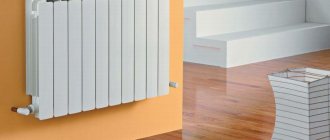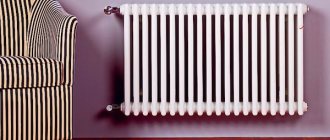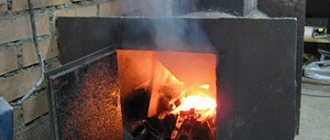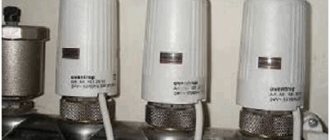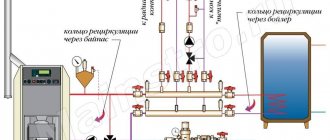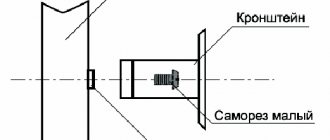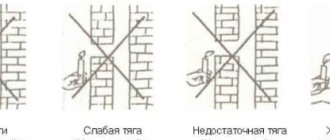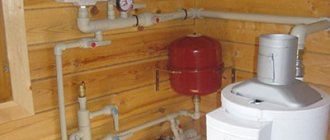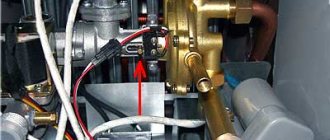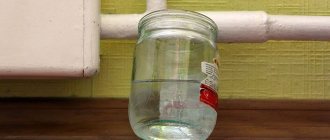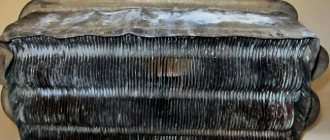There are frequent situations when the problem of a heating battery not heating arises. Sometimes you have to rack your brain in search of the reasons why the situation is happening and how to fix it. We have collected for you 7 possible reasons why radiators may not heat up and offer to study each in detail.
Important! This article is especially relevant when starting heating systems. Many, like you at the moment, may be experiencing difficulties with batteries. Your repost of our material may help someone quickly solve their problem. Don't forget to click on the social buttons. networks at the very bottom of the article!
Bypass
The bypass is the same pipe that stands in front of the installed heating device. Everyone has one, it’s needed to bypass water past the battery. If installed incorrectly - too far from the radiator, or in line with the central riser, it does not allow water, which tends to travel along the shortest path, to circulate normally, heating the radiator sections. In this situation, they will either not heat at all or will be very bad. Check how your bypass is installed. Perhaps this is the direct reason why the batteries do not heat up
What to do if bimetallic batteries do not heat up?
If during the heating season the apartment is not warm enough, then viral and cold diseases appear. Let's consider in what case bimetallic batteries do not heat up and what are the reasons?
First, make sure that the room temperature is below the established standards, which are as follows:
- If the room is located on the ground floor, then it should warm up to +20°C, and in the living room up to +18°C;
- The kitchen should warm up to +18°C;
- Bath up to +25°C;
- Corner room up to +20°C;
- At the entrance, on the staircase it should be up to +16°C;
- In the attic and basement up to +4°C;
- In the elevator up to +5°C.
How to correctly measure the room temperature?
In each room, measurements are taken at a distance of 100 cm from the inner wall, and it should be 150 cm from the floor. If they do not meet the above requirements, then there may be the following reasons:
- Debris has accumulated in the radiator;
- Air has collected in the system.
Radiators are dirty
First, check the pipes. If they are hot, then talk to your neighbors, if they heat up normally, then the reason is your radiators, which are clogged with dirt (metal oxide or other debris that does not allow the coolant to circulate freely). If you touch the top of the battery and feel that it is hot and cold at the bottom, then debris and dirt are located at the bottom. In this case, warm up the radiator from below, the coolant will heat up and begin to move through the system, and possibly dirt will leave with it.
It is quite difficult to clean dirty heating devices on your own, and therefore it is better to contact specialists who will clean them quickly and efficiently.
There is air in the radiator
It is important! Even if the heating radiators are new, and therefore not clogged with debris and dirt, then they have accumulated air, which can be removed independently. Each device has a tap, and by opening it you can drain the water, which will release air and cause the batteries to heat up.
The taps can also be installed on the riser. If a regular tap is installed, then you can simply open it, but if a Mayevsky tap is installed, then it is automatic and to open it you need to unscrew the cap and press the valve to drain the water, but before that you need to place a vessel under the heating device.
Next, close the tap and the radiator begins to heat up.
If you live in a private house and the bimetallic batteries do not heat well, then check each of the installed radiators and, if necessary, open the Mayevsky tap and drain the water.
Installation
Let's consider the existing types of connecting a heating battery to the system, which can be:
- Lateral;
- Nizhny;
- Diagonal.
With a lateral (one-sided) connection, the taps enter the radiator from the side, which ensures that the battery operates at maximum power, and if necessary, the heater can be easily replaced. If the length of the heating unit exceeds 160 cm, then a diagonal connection is used.
When the battery is connected to the bottom side, 90% of the total power of the heater is used. But such a connection is used extremely rarely, only in the case of baseboard wiring.
The bottom connection is used only when connecting to the heating system those heating devices that are designed specifically for this type of connection.
The diagonal connection to the system also ensures high-quality operation of the radiators, with the inlet pipe connected on one side from the top, and the outlet pipe on the opposite side from the bottom. This type is considered the best.
What do installation errors lead to?
If the radiators are not connected correctly, then the water is supplied not from above, but from below, and therefore it passes below and does not warm up the entire heating device. In this case, a coolant flow extension can help.
If the first few sections of the radiator are warming up and the owner is tormented by the question: - why doesn’t the bimetallic battery heat up? - the answer can be given by plumbers who will make calculations and correct all the shortcomings made during the installation of the system.
In order for the heating device to work properly and warm up the entire room efficiently, it is necessary to pay attention to the number of sections in a single unit, which should not be more than 12 (if the system is gravitational), and if it is circulation, then the number of sections should be from 20 to 24 knots. If there are more compartments, then the heater will not heat well.
If the diameter of the pipes for supplying the coolant is incorrectly selected, uneven heating of the batteries is also possible. For example, if the cross section is small, then the pressure is insignificant and is not enough to heat the system. To correct such an installation error, it is necessary to replace the pipes with the required diameter.
In order to increase the heat transfer of the heating device, it is necessary to keep it clean, and attach reflective material (foil can be used) to the wall behind it and paint the battery in a dark color (it emits thermal energy better).
Today it has become fashionable to install a heating battery with a thermostat in an apartment of a multi-storey or country house, but you don’t have to install a bypass pipe, but to do this, talk to representatives of the housing department.
Conclusion
For high-quality operation of the heating system, it is necessary to make the right choice when purchasing a heating device. How to connect a bimetallic battery to the utility network, or rather which connection method to use, is up to the owner of the apartment and the type of unit chosen.
In order for radiators to work well and heat the entire area, it is necessary to carry out high-quality installation in compliance with all requirements and recommendations. If this work cannot be carried out independently, you should contact specialists for help, who will quickly and with a quality mark install the heating system.
Source: https://santehkrug.ru/chto-delat-esli-ne-greyut-bimetallicheskie-batarei.html
Three way valve
Such a tap is required to switch the bypass-battery direction. If this is the reason that the radiator does not heat, then the problem can be eliminated in 3 ways:
- No disassembly. In cases where the tap turns easily, but switching does not occur at all (neither one nor the other works), you can try to develop the device using multiple turning movements. In this case, blockages, as a rule, are washed away by the flow, going into the riser. The operation of shut-off valves is restored in full.
- With partial disassembly. There's no way to turn the tap? We're not trying to break it. Carefully unscrew the locking screw of the handle, remove it, place the screw back in order to prevent deformation of the part during further work. Further actions are carried out with a wrench. It is not recommended to use round nose pliers, pliers, etc. The reason is the same as with the screw - not to damage the rod. Holding the rod with a wrench, we smoothly rock it back and forth, starting with minimal vibrations. If you cannot make minimal movements, slightly loosen the large hex nut that presses the stuffing box seal. If it starts to dig in, place a small container. Continuing the work, moving the rod, press the seal into place, turning the large nut back accordingly. We unscrew the screw, install the handle, screw in the screw, and rejoice.
- In rare cases, when the internal stop is simply torn off, the crane has the ability to “spun in a circle” endlessly - we simply select the position of the handle in which normal operation is ensured.
Why bimetallic radiators are hot at the top and cold at the bottom: reasons and solutions
In the era of global energy efficiency and energy conservation, having barely warm radiators at home is simply an unaffordable luxury. Uncomfortable microclimate, extra financial expenses - do we need it? I think no. Therefore, there is a reason to promptly identify and correct problems with the heating system, especially since you can perform some procedures yourself.
What are the consequences of inefficient operation of heating devices?
A certain part of homeowners believe that if bimetallic radiators are hot at the top and cold at the bottom, then there is no need to worry too much - it will somehow get better. In reality, this problem causes a lot of inconvenience, which may ultimately result in serious repairs:
- The efficiency of heating appliances decreases.
- Reducing the room temperature.
- Adjusting additional reinforcement does not correct the situation.
Important! Do not forget that a small temperature difference between the top and bottom of the batteries is not a significant indicator of malfunction. Another thing is a significant difference in heating; it negatively affects the heating efficiency.
New bimetallic radiators have a cold bottom while the top is hot: possible reasons
As already noted, for all models the heating of the lower region is weaker than that of the upper. This is explained by the high heat transfer of the bimetal - the water has time to cool thoroughly during the passage. Hence the temperature difference, which worries owners so much.
When not to worry
But with such insignificant differences there should be no reason for concern - this is a normal situation, given the features of this type of device:
- A single vertical channel in each section (for example, cast iron products have two).
- Small channel diameter (little coolant), but effective heat transfer due to the special configuration of the fins.
- Profiled convection channels between the ribs of the sections contribute to enhanced heat transfer, regardless of whether the battery is made by Italian or Russian.
- The thin walls of the sections heat up quickly, but also cool down just as quickly. Therefore, if you have bimetallic radiators at home and the bottom is cold and the top is hot near the appliances, this property needs to be taken into account.
Probable causes of uneven heat transfer
Despite similar trends, each case must be considered individually. If we ignore three important factors: incorrect calculation of the power of the boiler, pump and number of batteries, then we should take into account the likelihood of the following problems:
- Air jams are an inevitable consequence of measures to fill the structure with coolant. An additional symptom is gurgling or hissing sounds. The solution is the installation of a Mayevsky crane.
- Clogging of heating appliances is the result of neglecting regular flushing of the system, especially in apartments with a central heating system.
- Unsatisfactory coolant circulation - if distant heating units do not heat up well, then it is worth considering this reason, in particular in systems with natural circulation. To solve the problem when bimetallic radiators are hot at the top and too cold at the bottom, installing a circulation pump will help.
- Incorrect operation of the heating structure is a fairly common factor when the bypass is not adjusted. Even experienced home craftsmen who know how to properly install a battery with their own hands make mistakes when performing commissioning work.
- Problems with shut-off valves - proper installation of these units does not guarantee that over time the mechanism or electronic components will not fail.
Why are bimetallic radiators hot at the top and cold at the bottom after connecting: a reason to check the connections
Many home craftsmen decide to install it themselves, guided by considerations such as: there is nothing complicated here, or why spend extra money if you have the hands. This point of view is partially justified, but it would be nice to back it up with at least superficial theoretical information, which not many people do. So let's go over the top.
Incorrect installation of coolants: consequences
The main blunder when installing a two-pipe system is the incorrect choice of the direction of coolant flow in the pipes and its connection. A common mistake is that the pipe through which the supply flows is connected to the lower fitting of the heat exchanger, and the return is connected to the upper one. The result is obvious:
- Circulation processes are disrupted, and as a result, the efficiency of the system decreases.
- The removal of coolant from the device is disrupted; one half of the battery will heat up, but the other will not.
- Efficiency decreases, complete heat transfer is impossible due to incomplete filling with water.
The flow of hot liquid enters through the lower pipe, flows in a circle, and leaves the heating device without heating the sections. As a result, the bottom of even new bimetallic radiators is cold and the top is hot, and the efficiency of the system decreases. The fact is that the upper connection does not in any way contribute to the removal of coolant from the inside of the device, because its design does not allow the formation of increased pressure to remove water through the upper fitting.
Since a heated liquid has a lower density, unlike a cold one, when it gets inside, it tends to rise up. Therefore, the water follows the least path of resistance and does not mix in the sections.
How to fix the situation
A competent connection method guarantees the flow of hot water from above and facilitates its passage through the upper collector. Full heating is ensured by diagonal connection of radiators. However, it is not always done as expected, but it needs to be corrected. The algorithm is as follows:
- Disconnect the supply pipes from the fittings.
- Adjust the system diagram, taking into account that the supply flow goes through the upper pipe (it is connected to the upper pipe), and the return flow through the lower pipe.
- Connect the components to the heat exchanger.
- Open the supply and check the functioning of the system.
Human factor
A person can also become the direct cause of a non-heating radiator. And usually they are as follows:
- A riser that they simply forgot to turn on because “it was late and the plumbers were tired.”
- Closed valve of the automatic air vent system.
- Incorrect connection during installation.
- Child-closed three-way valve.
They can be solved by calling the appropriate support service, correctly connecting the battery (or bypass, see below), and carefully checking the taps.
Air jams
A common reason for poor heating of a bimetallic battery is airing of the system, which is associated with the accumulation of air bubbles inside the radiator. To avoid the formation of an air lock, a Mayevsky valve is installed on the line, which allows air to be periodically released manually or automatically. To activate the release of air masses, the manual valve is opened with a key or a screwdriver. Automatic models are equipped with a float, which automatically lowers when air accumulates and allows it to escape to the outside.
Flow extender
A typical problem for a two-pipe system. Is it possible to make any number of sections? It is possible, but the very last sections of the battery will not warm up. Cause? Water, like a person, looks for “where it’s easier” and follows the shortest path. In order to “teach order” to the lazy one - water, a flow extender is required. Factory-made, or made independently from a piece of pipe. By directing the fluid to the middle of the structure, it will force the flow to circulate correctly, reaching the farthest ends of the heat exchanger.
Interesting fact: the same problem can be solved by connecting the heating device “diagonally”. But this is rarely used, due to the lack of aesthetics of this solution on ready-made systems.
The radiator does not heat. What to do?
With the onset of cold weather, many are faced with the problem of non-functioning radiators and ask a reasonable question: “Why are the batteries cold? After all, everything was fine last winter.” This problem, by the way, is one of the most common in the heating sector. Why does this happen, what reasons can provoke the problem and what should you do if you freeze at the very beginning of winter? Let's figure it out.
Are the radiators in your apartment heating poorly?
So, first you need to do a superficial check. It doesn’t take much time, but in this way you can eliminate factors not related to breakdown or malfunction.
1. Pay attention to the valve. The battery may be blocked. In order to assess whether the valve is in the correct position, you need to remember that when open it must stand parallel to the pipe. When the valve is closed, it takes a perpendicular position. For clarity, take a look at the picture.
2. Contact the management company. There they must inform you about heating outages.
3. Discuss the problem with your neighbors. In many houses in our country, the coolant supply system is a single-pipe version. In simple terms, with such a system, one pipe goes to the ceiling and one to the floor. In addition, neighbors, as a rule, do not have jumpers between pipes (bypasses). Thus, when a neighbor on the second floor blocks the radiator, all the residents above will suffer, since heating, in this case, is turned off for all apartments along the riser. What should be done? It's simple: check if the heating of your neighbors below and above is blocked (in some cases, the coolant is supplied from the upper floors).
We have looked at the simplest reasons that can make you freeze in your own apartment. Unfortunately, heating problems are not always of such a banal nature, so we suggest that you familiarize yourself with the malfunctions and problems that are directly related to heating radiators.
Balancing valve
Privately owned houses have the greatest variety of heating systems. Cases of two or three branch structures are not uncommon. In this case, as in the above cases, the tendency of the liquid to take the shortest route naturally remains. The longest arm may have no circulation at all or very weakly expressed. The heat transfer of such a link will be the same - small, absent. The battery will not heat or heat poorly.
To eliminate the situation, it will be necessary to install a balancing valve in order to equalize the pressure of different branches and uniform heating.
Where to contact
- Call the control room of the management company (MC) servicing your home. You can find its number in payment documents or on the information board at home. Check to see if any technical work is currently being carried out.
- If not, you should contact your neighbors in the riser; perhaps they have closed the circuit for repairs.
- If you are sure that the reason does not lie in your house or apartment, and the temperature is below the established standards, you have the right to call an engineer from the management company to draw up a report and eliminate the reasons.
Clogged radiator
Sometimes the reason that the radiator does not heat can be a simple blockage. When determining the causes of blockage, let’s highlight the symptoms:
- It only warms around the perimeter.
- Only the top part.
- The bottom is heated, the top is not.
- Only a few sections out of all possible provide heat (if the bypass location is correct)
Could it be just the old battery that is clogged? Not at all. New systems (modern and ultra-modern, aluminum and cast iron) suffer from this just as often. The problem may lie in the general contamination of the system:
- From long-term use.
- Due to installation errors.
- Sediments with high water hardness.
- Erosion of system elements (oxide, rust).
How to get rid of it?
Modern heating devices with properly installed shut-off valves include an “American” valve, by turning off which the non-working part can be easily dismantled and cleaned, purged, and washed under pressure.
It’s harder where the equipment is “countless years old.” To disassemble, you may have to turn to specialists, emptying (preliminarily or with their help) the entire volume (usually just water).
Cast iron radiators can be cleaned. It is recommended to replace steel flat flow welded radiators with new ones of other models. But it is they, ironically, that are most often susceptible to rusting and clogging of channels - due to the design features and materials used. Therefore, they often do not heat properly. An additional reason not to clean this type of heating device is the risk of leakage of the eroded wall due to its thinning in the process of peeling off oxidized metal flakes. A leak can be costly (even if you forget about the cost of repairing the “junk”). This is the same case when the stingy one has every chance to pay twice, or even three times.
Interesting fact: cast iron radiators clog 3-5 times less often than aluminum or stamped ones.
Troubleshooting
First you need to find the reason for the uneven heating of the radiator. It is often enough to release the air trapped in the heating system, especially at the very beginning of the heating season.
It is recommended to flush and clean pipes and heating radiators at least once every 7 years.
If the heating riser pipe is hot, and the radiator is much colder or does not heat up at all, you should check the condition of the shut-off and control valves. It is better to entrust this to a specialist.
It is worth paying attention if the neighbors are doing renovations. If they change heating radiators, install heated floors, change heating risers - all this can directly affect the temperature of the radiators in your apartment for the worse. In this case, you should contact the management utility company.
Useful tips
When starting the stage of restoring heating efficiency, you need to analyze the situation and determine the cause of the problem. The course of action is as follows:
- Check the correctness of communications.
- Check for air in the system and, if present, release it.
- Inspect the heating device and clean the internal cavity.
- Assess the functional condition of shut-off valves and control valves.
- Determine the performance of the system, if necessary, change or install a more powerful pump.
If you find a situation where the bimetallic radiators are very hot at the top and cold at the bottom, it is worth checking the control valves (if any are provided for in the project). It is necessary to immediately remove such a unit and conduct a detailed inspection. If deposits are found that narrow the cross-section, they should be removed. However, the best option would be to replace the part with a new one.
Low system pressure also does not contribute to efficient heat transfer. This may be due to the pump, or its absolute absence. Therefore, it is not without reason that experts advise installing modern equipment. This is the only way to obtain high-quality heat supply.
